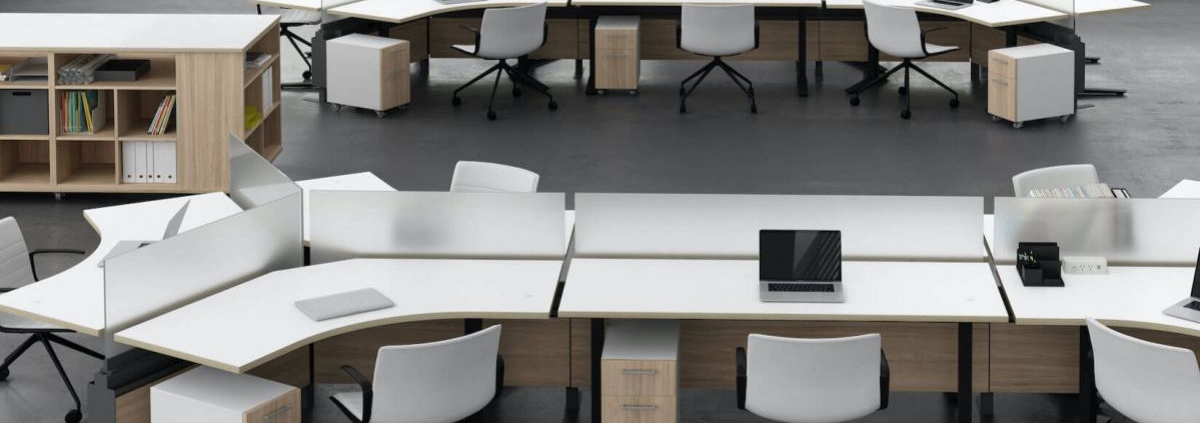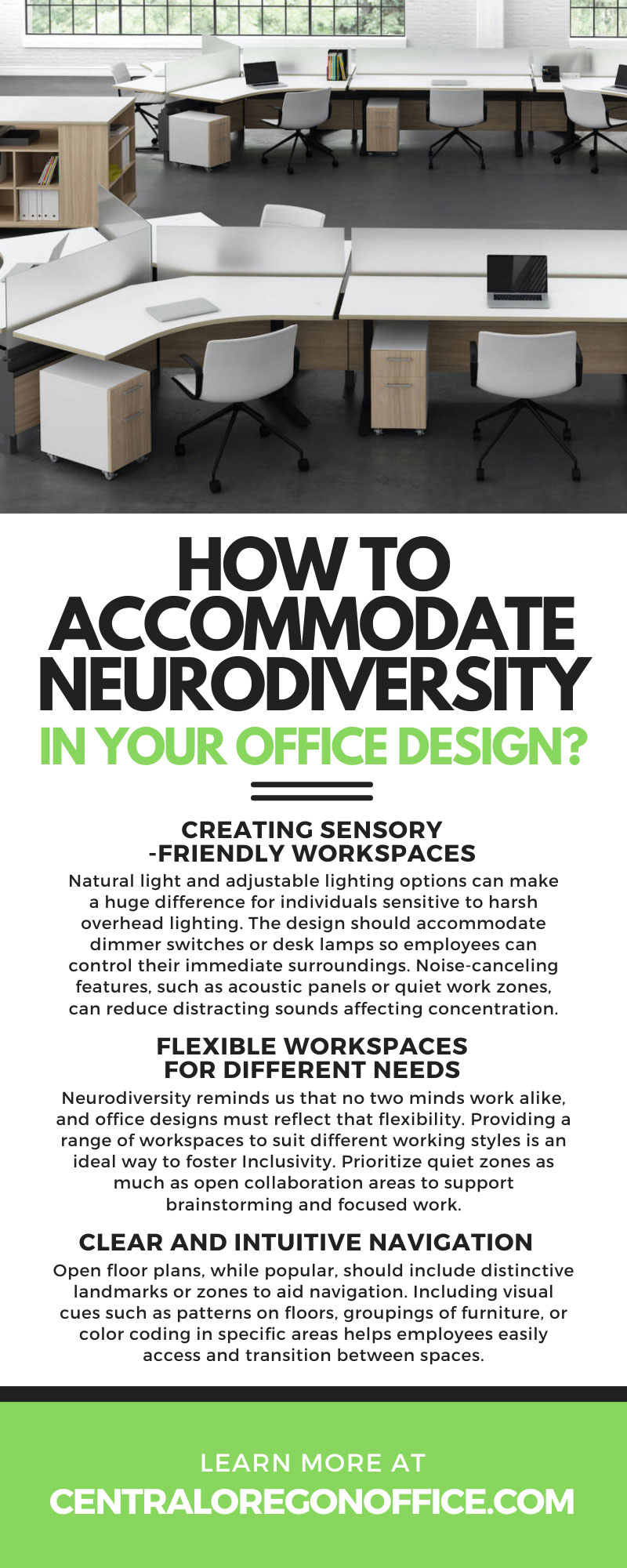How To Accommodate Neurodiversity in Your Office Design?
The modern workplace is evolving rapidly, and with this progress comes an increased understanding of the diverse needs of employees. Learning how to accommodate neurodiversity in your office design is crucial for businesses to create an inclusive and supportive workplace. Neurodiversity encompasses a wide range of neurological differences, such as autism, ADHD, dyslexia, and more. Building an office environment for everyone promotes employee well-being and fosters creativity, innovation, and productivity.
Why Neurodiversity Should Be a Priority in the Workplace
Understanding and incorporating neurodiversity into workplace design is a necessity for forward-thinking organizations. By recognizing the unique strengths and challenges of neurodivergent employees, companies can unlock a competitive advantage. Inclusive spaces can improve morale, reduce workplace stress, and increase retention rates among employees who may feel overlooked or unsupported.
Designing spaces with neurodiversity in mind shows a commitment to creating equality in the workplace. Businesses demonstrate their values and commitment to diversity, equity, and inclusion by providing an environment where everyone can excel. This ensures all employees feel seen and valued, improving workplace culture and collaboration.
Creating Sensory-Friendly Workspaces
One of the most significant considerations in accommodating neurodiversity is managing sensory stimuli. Everyone processes sensory information differently, and for neurodivergent individuals, certain environments may be overstimulating. Office spaces should consider lighting, noise levels, and textures to ensure all employees feel comfortable and supported.
Natural light and adjustable lighting options can make a huge difference for individuals sensitive to harsh overhead lighting. The design should accommodate dimmer switches or desk lamps so employees can control their immediate surroundings. Noise-canceling features, such as acoustic panels or quiet work zones, can reduce distracting sounds affecting concentration. Additionally, tactile considerations, such as soft seating options and smooth surfaces, can enhance the overall sensory experience.
Flexible Workspaces for Different Needs
Neurodiversity reminds us that no two minds work alike, and office designs must reflect that flexibility. Providing a range of workspaces to suit different working styles is an ideal way to foster Inclusivity. Prioritize quiet zones as much as open collaboration areas to support brainstorming and focused work.
Designing flexible workstations means including quiet pods, small, enclosed rooms, or spaces where individuals can unplug without distractions. Breakout spaces with comfortable furniture and whiteboards encourage creativity for brainstorming sessions or collaborations. The opportunity to rotate between these areas allows employees to choose environments that best match their energy, focus, or goals.
The Role of Movement in the Workplace
Movement can be crucial in accommodating neurodivergence, improving productivity, and minimizing stress. Often, neurodivergent individuals benefit from spaces that allow opportunities for physical movement. Office layouts, including standing desks, treadmill workstations, and areas for stretching, can help individuals stay energized throughout the day.
Hallways or open spaces can double as mindfulness zones where employees can walk or move to regulate their thoughts and emotions. Flexible seating arrangements that allow employees to move naturally during the workday are also beneficial. Incorporating these elements supports neurodiverse employees and has broader health benefits for the entire team.
Color and Design Choices That Promote Focus
How you design and decorate spaces can impact focus and comfort for neurodivergent employees. Neutral tones and soft colors foster calmness without becoming overly stimulating. However, having splashes of color strategically placed for creativity and mood enhancement can create balance.
Avoid chaotic artwork or cluttered designs that may overwhelm sensory processing. Instead, opt for minimalistic decor complemented by thoughtful pieces that inspire but don’t distract. Plants and natural elements can also create a relaxing environment while improving air quality.
Clear and Intuitive Navigation
An inclusive workspace design makes navigation simple and intuitive for everyone, especially neurodivergent employees. Offices should use clear signage that provides accessible instructions on where to find meeting rooms, restrooms, or kitchen spaces. Consistency in labeling and organization can create predictability, reducing stress for employees relying on such systems to orient themselves.
Open floor plans, while popular, should include distinctive landmarks or zones to aid navigation. Including visual cues such as patterns on floors, groupings of furniture, or color coding in specific areas helps employees easily access and transition between spaces.
Dedicated Relaxation Areas
Relaxation or sensory recovery rooms offer a safe space for employees to reset during an overstimulating day. Providing something as simple as a dimly lit room with comfortable furniture and soothing music can significantly impact mood and productivity. These areas are especially important for neurodivergent employees who may need time to unwind before re-engaging with work tasks.
By giving everyone access to spaces designed for mental and sensory breaks, workplaces normalize taking care of one’s well-being. This approach improves engagement and builds a supportive workplace culture.
Leveraging Smart Technology To Empower Employees
Smart technology has become an essential tool in designing inclusive office environments. Voice-controlled assistants, light dimmers, and automated room temperature controls allow employees to tailor their surroundings to fit their needs.
Smart scheduling software for reserving quiet work areas or wellness rooms efficiently and fairly allocates resources. Additionally, providing tools like noise-canceling headphones shows thoughtfulness in helping employees manage sensory overwhelm.
Training and Awareness for the Whole Team
Creating a more inclusive workplace doesn’t stop at design. Educating the wider team on neurodiversity is a powerful way to build an empathetic and supportive office culture. Workshops or seminars led by experts can help employees better understand their neurodivergent colleagues.
Awareness training reinforces respect and consideration in communal spaces. Co-workers who understand how stimuli like noise or light can affect some individuals are more likely to be accommodating. Investing in education sets the foundation for a workplace that values inclusion at every level.
Encouraging Employee Feedback on Office Design
To truly accommodate neurodiversity, organizations must listen to their employees regularly. Soliciting feedback through surveys or one-on-one meetings will provide valuable perspectives on improving office design. Because needs vary widely, ensuring your approach includes ongoing dialogue adapts the office to evolving requirements.
When soliciting input, remain open to exploring unique or creative solutions that may emerge. Employees are the experts in their own experiences, and their insights co-create an environment where everyone thrives. Fostering this collaboration strengthens both engagement and trust.
The Business Case for Inclusive Office Design
While the main goal of neurodiverse office furniture and design is to support employee well-being, it also brings measurable benefits to businesses. Inclusive environments foster innovation, creativity, and improved performance, as employees feel empowered to perform at their best. Reducing stress and creating spaces that allow everyone to thrive can lead to higher retention rates and a more engaged workforce.
Furthermore, companies that prioritize Inclusivity strengthen their employer brand, making them more attractive to top talent. Inclusivity is a statement about your organization’s commitment to its people, and this commitment resonates far beyond the office walls.
Building the Neurodiverse Workplaces of the Future
Accommodating neurodiversity in your office design requires careful planning, empathy, and a commitment to Inclusivity. You can create a workplace where everyone can succeed by implementing sensory-friendly spaces, flexible arrangements, intuitive navigation, and employee feedback mechanisms. These changes reflect good business sense and a deeper principle of valuing each employee for who they are.
Now is the time to transform your office into a space that embraces the strengths of neurodiverse individuals. If you’re looking to redesign your office or aren’t sure where to start, our design consultants at Rose City Office Furnishings are here to help.




